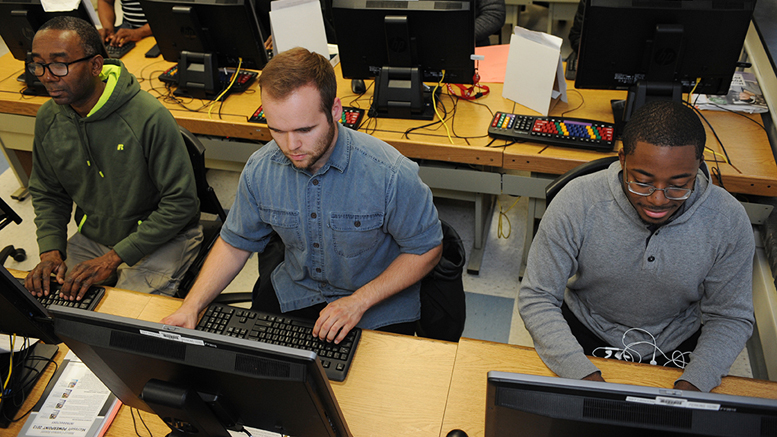Community colleges are key to increasing diversity in technology, yet transfer rates in computer science (CS) tend to lag compared to other programs.
As a result, college and technology industry leaders are working to improve the transition process and provide more supports to CS students, with a special focus on women and minorities.
While the national focus in CS education has been on K-12 and university education, “community colleges are overlooked,” says Sepi Hejazi Moghadam, head of research and evaluation for computer science education at Google. “That’s unfortunate because community colleges produce half of college graduates and more than half of black and Hispanic graduates.”
A study by Google with the Community College Research Center found that of the 1.8 million first-time college students who entered a community college in fall 2007, only 3,290 went on to earn a bachelor’s degree in CS.
Those students were not representative of the community college population, Moghadam says. Only 12 percent of them were female, for example, compared to 50 percent of transfer students who earned bachelor’s degrees in a STEM subject and 56 percent in any subject.
For those who do choose careers in computer science, there are plenty of opportunities.
“The current graduation rates in computer disciplines may satisfy only one-third of the projected 1.4 million computing-related jobs openings in the coming years,” the Association for Computing Machinery (ACM) reports.
The few students who successfully started in community colleges and went on to each a bachelor’s degree in CS shared several characteristics, Google found.
“They were unusually focused and fortunate,” says Moghadam. They were more likely to start college earlier, didn’t change schools frequently, went to community colleges located in technology hubs, and transferred to four-year schools that provided extensive supports to transfer students.
Many challenges
Students who attend community colleges on the way to bachelor’s degrees in CS encounter many challenges, according to the Google report. Among the obstacles: lack of clear pathways; insufficient information about pathways and the courses students need; limited capacity at both two- and four-year institutions; lack of clear articulation agreements; and students given insufficient information about career opportunities.
Among the 3,290 students who earned bachelor’s degrees, there were 1,213 separate paths to graduation, according to the study.
The nature of the community college student – many are working and have families, and they often have personal or financial challenges – means “they face uncertainty and that creates a lot of swirl for students,” says Moghadam.
Also many community college students interested in CS are often confused and anxious about the academic requirements and might need to brush up on their math skills.
All of that means they need more support services, he says.
Community colleges should encourage students to choose a major early, and if they choose CS, help them stay on track, Moghadam says. He advises community colleges to be more welcoming to students from underrepresented groups and provide scholarships and other supports for them.
The industry should work closely with higher education to provide real-world projects and “connect the dots between school and careers,” Moghadam adds, and should encourage women and minorities working in tech to serve as mentors.
Well-defined pathways
The research was mainly done in 2014 and by the time the study was released in 2016, much progress had been made, Moghadam says. He’s seen “lots of passion in community colleges” in supporting CS programs and notes that the National Science Foundation is funding a workshop to be scheduled in early 2018 to broaden community college participation in CS education.
Moghadam calls transfer guidelines issued in September by the ACM a step in the right direction. Those guidelines, developed by ACM’s Committee for Computing Education in Community Colleges, aimed to ensure two-year and four-year institutions are in sync about the courses CS students should take.
“Computer Science Curricular Guidance for Associate-Degree Transfer Programs with Infused Cybersecurity” is based on input from more than 70 community college and university educators, as well as practitioners in the industry. The document outlines competencies and learning outcomes that should be covered in CS associate-degree programs. It also provides a map of assessment metrics and stresses the importance of “soft skills,” such as the ability to work in teams and solve problems creatively.
The transfer guidelines call for more structure, more supportive pathways, well-defined articulation agreements and specific CS program maps. They recommend that CS programs in community colleges provide a strong foundation in mathematics, CS laboratory experiences, rigorous science laboratory courses and access to strong student support services.
Extra support
The ACM transfer guidelines “are designed to keep students current with the rapidly changing demands of colleges and the workplace,” says committee member Elizabeth Hawthorne, a senior professor in computer science at Union County College (UCC) in New Jersey and a primary author of the guidelines.

Students in a computing class at Union County College. (Photo: UCC)
There are about 60 students in computer science and 80 in information technology at UCC. Most UCC students who earn an associate degree in CS transfer to Rutgers University, the New Jersey Institute of Technology or Stevens Institute of Technology, although some go out of state, Hawthorne says.
UCC is developing guided pathways to prevent students from taking unnecessary courses. And to guard against unforeseen requirements or curriculum changes at universities, Hawthorne and her colleagues maintain close relationships with faculty at the transfer-in institutions.
“If students realize they need to take an extra semester after they transfer, it affects their financial aid,” she says. “That could really make or break whether they graduate or not.”
Because Hawthorne is the only female professor in CS at UCC, she works on making sure the female students – there are about 10 of them – feel welcome. She also helps recruit female speakers for the computing club and encourages students to participate in the Hour of Code and similar events.
Overcoming obstacles
“The ideal transfer pathway would be 2+2 with all the credits transferring, allowing students to earn a bachelor’s degree in four years,” says Cara Tang, chair of the computer information systems department at Portland Community College (PCC) in Oregon. That is not typical, however.
“Unless a student knows exactly what school they want to transfer to and what they want to study, it could be tough,” says Tang, who also served on the ACM committee that wrote the transfer guidelines.
PCC doesn’t confer CS degrees; the program is geared to transfer students. The college is working on providing an associate degree so students will at least have a credential when they complete the coursework, Tang says.
Universities tend to hesitate in accepting CS credits from community colleges, she notes. In Oregon, there is no statewide transfer system, so there’s a patchwork of separate articulation agreements, she says, with some universities accepting more credits than others.
And because community colleges are open access, many students find they have to take introductory or remedial math courses to make up for what they didn’t learn in high school.
For all of those reasons, it usually takes more than four years to earn a CS degree from a four-year institution in Oregon, she says.
Another hurdle is the required proficiency exam to get into the CS program at Portland State University, the main transfer school for PCC students. The failure rate for students transferring from any school is 70 percent. Students who fail only get one chance to retake the test.
“That’s been a challenge for a lot of students, so we’re focusing on getting students ready for the exam. It’s a stressful setting,” she says.
Students who don’t get into Portland State can transfer to a less-competitive school, such as Western Oregon University, or they can switch to a less-demanding major, like information technology.
The state of Oregon has established a council of the chairs of CS departments in higher education to develop a closer working relationship and smoother transfers. The group is looking at learning outcomes and better ways to package courses, Tang says.
“It’s an ongoing challenge, as we try to build smooth pathways for students,” she says.

